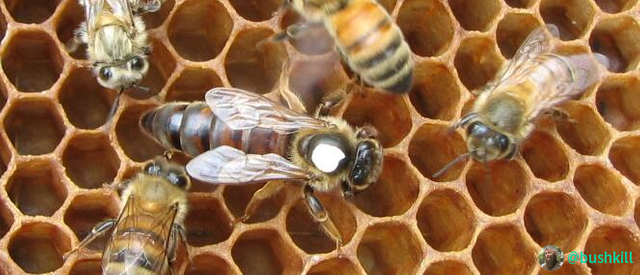🐝 Beekeeping For Everyone! - #4 - Honeybee Queen - part 1
The queen her highness? Maybe not. Last post talk about the castes of the honeybee colony. This post will delve into more details on the honeybee queen.

As previously discussed, the queen is raised from a fertilized egg and the larvae is feed royal jelly the entire time it is growing. This allows for the queen to fully developed and be sexually mature. All other females are stunted and cannot reproduce.
Is the Queen in charge?
Remember, we gave her the moniker of 'Queen', not the bees. We also associate the name queen to be part of the hierarchy that is in command. Bees think differently. Although the queen is the only one who can produce viable offsprings, which are the life blood of the colony and it's future, she is not the supreme ruler. The worker bees care for the queen and feed her. They determine when it is appropriate for her to be raising brood and will change her diet as needed. The workers also decide when it is time to swarm (we will cover swarming in a future post) and will change her diet to slim her down so that she is capable of flying. But even more interesting, is that the worker bees have the power to dispatch the queen and raise a replacement if they so choose.
Who is the Queen?
Although we discussed the diet involved in raising a queen, one point we did not discuss was the cell orientation. Because the queen is substantially bigger than a worker bee, the cell she is raised in must be bigger as well. The bigger cells resemble a peanut and are oriented vertically. Why vertically? I don't think there is a definitive answer, but I speculated it is easier to build a queen cell vertically and take advantage of the spaces between combs. It has been proven that a queen can develop just fine in a horizontal cell (same orientation as workers/drones) as can a worker or drone in a vertical orientation.

There are 3 types of queen cells.
Emergency cell
This is where the queen suddenly dies or is un-expectantly killed. Emergency queens are the worst case for the bees. They have no laying queen and the colony will perish if the situation is not rectified. There is no current queen so one is raised from eggs laid in worker cells. What differentiates a queen from a worker is the food that is fed to the larvae on or around day 3. This happens to coincide with the bees needing to get the larvae from the horizontal cell to the new vertical cell they build on the face of the comb.

To get the larvae to the correct position, they float it out on thinned out royal jelly. Does this thinned out royal jelly have the same nutritional value? Right at the critical time of a larvae being either a worker or a queen. There may not be an abundance of resources for the bees to produce quality royal jelly and they just do the best they can. Out of necessity, they will attempt to raise multiple emergency queen in hope that one is successful. Any larvae that may be a little older (more than 3 days and didn’t continue to get feed straight royal jelly) will also be the first to hatch and kill all the younger, perhaps better quality, unhatched queens. I also often hear that bees will know and always select the right aged larvae. Out of desperation, bees will try and rear a queen from a non-fertile laying worker larvae (drone), so wouldn’t it be plausible they would attempt to rear from a slightly older than prime larvae? I personally do not keep queens that have been raised under the emergency method.
Supersedure cell
This is where the colony is not happy with the performance of the current queen and decides to replace her. Supersedure does not consider availability of resource or drone population for proper mating. Supersedure queens are reared from eggs of an unacceptable and/or failing queen, therefore results are marginal at best. You will find some folks that say supersedure queen are perfectly fine. Just keep in mind, that although young supersedure queen may seem just fine, come fall, when the weather starts getting tougher is when the poor quality is most likely to show up. This also, coincidentally, is the worst time to have to try and requeen. I have also seen, and heard from many beekeepers, of hives that will perpetually supersede the queen. This leads me to believe that whatever quality of the queen the bees do not like is being passed through genetics. I have had too many supersedure queen fail in the fall, so I will replace them as well
Swarm cell
The swarm cell is the cream of the crop when it comes to raising new queens. I would even argue better than queens produced by professional queen breeders other than the fact that queen breeders usually have exceptional stock to rear from. Swarms cells are produced when a colony is at it's prime, resources are abundant, and conditions are ideal. The workers create vertical queen cups that the queen will lay directly into. The larvae will be feed in abundance and cared for by a large population of nurse bees. Although swarm cells produce the best queens, they also lead to a colony swarming. Which is not desired by the beekeeper. Well will discuss swarm prevention in the future
Sixteen days after the egg was laid the virgin queen emerges from her cell. Most times the colony will raise multiple cells at a time, so the queens first action is to hunt down other cells and kill the unhatched queens. A queen hatched by chewing through the tip of the cell to create an opening. When she goes and kills unhatched queens she chews through the side of the cells and stings the helpless unhatched queen.
Normal hatched queen cell

Destroyed queen cell

A newly hatched virgin queen, although fully developed, will not reach her full size until she is mated and ready to start laying eggs. As seen the picture below, She does have a larger, distinctive thorax (middle section) than worker bees, but her abdomen is not much bigger than a workers at this point.

I think that is enough information to try and digest for now. In the next post we will continue on with her preparing for flight, mating, egg laying and swarming. Stay tuned!
Interested in Beekeeping?
Follow me (@bushkill) so you don't miss the next post in the Beekeeping for Everyone! series
Check out the previous posts in the Beekeeping for Everyone! series
#1 - Introduction
#2 - The Importance of Pollinators
#3 - Honeybee Castes
Also check out these favorites:
Why You Should NEVER EVER Kill Honeybees Living in Your House
The Mysteries of a Bee Beard Revealed!!
Talk Beekeeping

https://discord.gg/RwmvvFH
Beekeep On!
![]()
@bushkill
I like your consistency sir. All i love about bee is the medicinal part and the honey focus.
@seyiodus.
Its intense to imagine the depth of culture embedded in the instincts of bees.
Yes it is! Thanks irwin
I am actually in love with beekeeping but am far away from you.
@stevenmosoes
Bees are everywhere 😜
Wow, @bushkill! It's amazing how much there is to learn about bees! Have you reached out to the homesteading groups within Steem?
Thanks Karen, I have reached out the the homestead crowd and have been making some new acquaintances. I have started a beekeeping discord channel with one of the beekeeping homesteaders and we are slowing drawing in members.
like always some great job, a lot of information, greetings
thanks jack...👍🏻
your welcome
Thanks for putting together these bee posts for us newbees! Very interesting stuff! Still crossing my fingers that my two hive survive the winter.
Yes, wintertime can be very tough on one's mind as there is really nothing we can do but hope. Preparing them well for winter in early fall is the best insurance. The rest is up to mother nature. Best of Luck.
I'm myself a beekeeper (with my father) so voted) what would a world do without us)
thanks👍🏻
Lots of good info. I plan on getting bees on my homestead in the near future. I'll definitely be check out you page.
Honeybees are a great addition to a homestead. Not only do they help with the pollination of your gardens, but also give a sweet reward.
YES they live to work from what I'v learned and i wont mind letting them. :)
For someone with 0 experience beekeeping, what are your thoughts on this: https://www.amazon.com/gp/aw/d/B01HPOBF48/ref=pd_aw_sbs_86_2?ie=UTF8&psc=1&refRID=XEGPEKTWZ37NWV0ZJK9G&dpPl=1&dpID=61ABG1yUHIL or the Flow Hive?
I have no experience with these hives, but I am a HUGE proponent of insulated hives. I have been using them for over 10 years now and have tried many different brands. My favorite are these -> https://www.betterbee.com/beemax-hive-kits/beka-beemax-essentials-kit.asp If you have the time, I did a talk in November on Thermodynamics of Beekeeping (Why Beekeepers have it all Wrong), which goes through the details of the importance of insulated hives if you compare to the bees living in a tree. The audio recording can be listened to here -> http://beeimprovement.com/audio-library/ You may need to scroll down a little to find it.
As for the flow frames, the design in ingenious but I wouldn't recommend them for a beginner. Yes they do work, but things have to go almost perfectly. There are too many pot holes that a beginner can step into with them. Furthermore they aren't designed for insulated hives, though I'm sure they can be adapted.
I have a bunch of the standard boxes from Mann Lake. Do you think they would be compatible with the insulated hive you recommend? Didn't know about these until now. Thought maybe a hybrid approach could be taken, use the insulated hives on the bottom and use the cheaper wooden ones on top as supers. Once winter hits, pull the honey and let them go into winter, warm and snug. Any thoughts?
That is exactly what I do and the main reason I prefer the BeeMax over the other insulated brands of hives. Standard Langstroth wooden hives are completely compatible with the BeeMax. All the other insulated hives I have tried either have screwed up bee space between the boxes or the frames don't fit right. As much as I want to like the modern interlocking poly hives, I just can't get the same function with them as the beemax. I also prefer the beemax nucs over the other brands as well, even though they can't be doubled up.
Awesome! I will definitely consider a Beemax now, especially if my bees don't survive the winter.
The standard for winter here is 2 Langstroth deeps with at least 90lbs of honey. Mine go through winter in 1 deep and even on the coldest winters have 3 or more frames of honey left. Just like your home, the better insulted thee less fuel you burn. 🔥
I really appreciate the advice!
@originalworks
The @OriginalWorks bot has determined this post by @bushkill to be original material and upvoted it!
To call @OriginalWorks, simply reply to any post with @originalworks or !originalworks in your message!